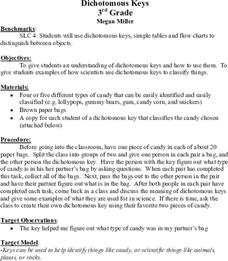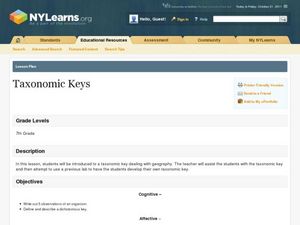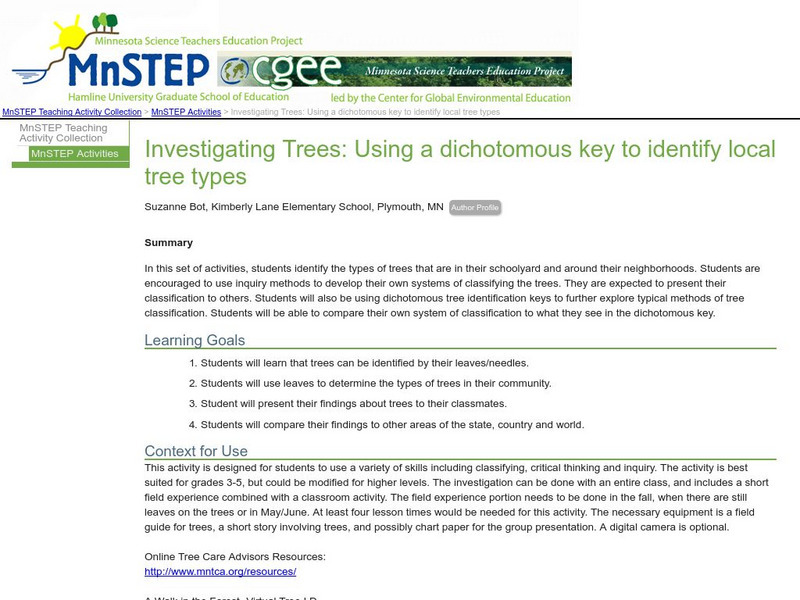Curated OER
Desinging and Using a Dichotomous Key
Pupils are examine the purpose of dichotomous keys. In groups, they design their own in order to describe the characteristics of plants and weeds native to California. To end the lesson, they define new terminology associated with the...
Curated OER
Dichotomous Chips
Young scholars create a dichotomous key to different varieties of potato chips. In small groups, they observe and record characteristics of the potato chips to use in the key. They switch keys with another group to see if they can...
Curated OER
What is in a Name?
Students examine taxonomy and the use of dichotomous keys through two activities. They use a dichotomous key and create one of their own as well as create new scientific Family names for penguins using same word roots used by taxonomists.
Curated OER
The Food Pyramid
Fourth graders plan a variety of nutritional meals using the USDA's Food Guide Pyramid as a reference and analyze food labels to plan their meals. They examine and discuss the Food Pyramid, and create dichotomous keys separating food...
Curated OER
Dichotomous Key for Identifying Pine Trees
Pupils identify the species of pine trees that are found in their area. They use unlabeled "mystery" samples and a dichotomous key to identify the pine trees to species. After identification, they use a field guide to answer worksheet...
Curated OER
Introduction To the Classification of Organisms
Students discuss how scientists classify organisms. In pairs, they analyze and label "specimens" of breakfast cereals in order to classify them into the correct group. They create a dichotomous key for several species of animals.
Curated OER
Dichotomous Key
Eighth graders use a dichotomous key to identify unknown fictitious organisms. They work individually during this exercise. The task is designed to take students approximately 15-25 minutes to complete.
Curated OER
Jewel of the Earth
Pupils investigate several organisms, set sticky traps to collect them, and attempt to identify and classify them using a variety of sources. The origins of the organisms are traced and their adaptive features examined.
Curated OER
Dichotomous Keys
Students classify objects and organisms using a dichotomous key. They are shown a demo by the teacher and then practice on their own. They discover why classification is important.
Curated OER
Dichotomous Keys
Third graders practice using dichotomous keys. They discover why scientists use them and why it is important to classify animals. They use candy to practice classifying objects and move on to classifying animals.
Curated OER
Everybody Needs a Rock
Students, after making quantitative and qualitative observations of their rocks, construct a Venn diagram or dichotomous key to classify their rocks.
Curated OER
The Sky and the Dichotomous Key
Students use a dichotomous key to distinguish between different types of clouds
Curated OER
Building a Dichotomous Key
Students analyze how a dichotomous key helps us explain and identify unknown organisms. They design and construct a dichotomous key, developing a list of three observable characteristics per organism.
Curated OER
Taxonomic Keys
Seventh graders create their own dichotomous key. In this biology instructional activity, 7th graders classify animals based on their observable features. They explain how to use their dichotomous key.
Curated OER
Classification: Dichotomous Key
Learners explain the classification process of organisms. In this biology lesson, students practice writing the names of organisms scientifically. They answer the dichotomous key and discuss answers as a class.
Curated OER
Dichotomous Key
Learners develop an understanding of how a dichotomous key is organized. In this dichotomous lesson, student are put into small groups, and work together dividing their group of similar objects (buttons, paper clips, screws, keys...)...
Curated OER
Invertebrate Classification
High schoolers discuss the recent disovery of the "furry lobster" to peak interest in the animal kingdom. They classify various speciments using invertebrate dichotomous keys, identifying major animal phyla and classes. Thy the complete...
Curated OER
The Sky and the Dichotomous Key
Learners conduct observations and use a dichotomous key to identify clouds they see.
Curated OER
Paleoecology of "Fossilized" Owl Pellets
Learners examine fossilized owl pellets to determine how a species environmental preferences allow us to reconstruct probable past environments. Differences in anatomy are used to identify species in this lesson.
Curated OER
Classifying Organisms within Kingdoms
Students examine animal kingdom classifications. They discuss how animals are placed into kingdom classifications and compare similarities and differences of animals within a kingdom.
Curated OER
Bean Sort
Students define and discuss dichotomous keys. They create a dichotomous key to identify a bag of mixed beans, and assign their group of beans a genus and species name.
Science Education Resource Center at Carleton College
Serc: Investigating Trees: Using a Dichotomous Key to Identify Local Tree Types
Using their own classification methods students will identify the types of trees found around their school and neighborhoods. Students will then present their classification methods to the class. Later students will use dichotomous tree...
Other
Alice Ferguson Foundation: Bridging the Watershed: Plant Identification
Use this interactive guide to identify plants based on their leaves. For each step, you are given two choices, and you continue down the branches until you discover a plant's name.
Texas Education Agency
Texas Gateway: Dichotomous Key
This tutorial is introduces students to the usage of the dichotomous key.

























